699 Search Results for communication book
November 3, 2016
by Carole Zangari -
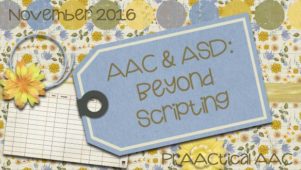
Today, we welcome Dr. Kimberly Ho, SLP and Director of Speech, Language and AAC Services at Confidence Connection in Needham, Massachusetts. In this post, she discusses how professionals in her organization are supporting AAC learners with autism on the journey toward flexible, generative language. I am the Director of Speech, Language and AAC Services at an ABA clinic, so naturally we serve many individuals with Autism Spectrum Disorder (ASD) of all ages. A vast number of learners with ASD can speak, but their speech is not functional to meet their communication needs. We have begun to provide word-based AAC systems for these students to move beyond scripting. Many individuals with ASD “script.” That is, they may not produce novel utterances, but rather chunks of phrases and sometimes entire sentences they have memorized. Sometimes this scripting is based on a character from a TV show or movie. Other times the script has been memorized in... [Read More...]
October 31, 2016
by Carole Zangari -
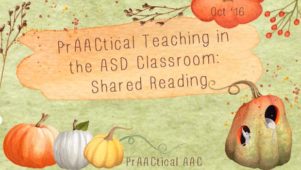
We are pleased to have a return visit from special educators Lauren Pawlowski and Amy Devin with ideas for supporting AAC learners in the classroom. Amy and Lauren, who work in the public school system in Michigan, taught in resource rooms for years and have been teaching in self‐contained ASD elementary classrooms since 2009. At that time, there were few classrooms who were integrating core language instruction, but they didn’t let that stop them. Currently, they use manual communication boards, large instructional core boards, and individual AAC devices with their students. They are passionate literacy teachers and, in today’s post, tell us about their approach to shared reading lessons. Their video is chock full of tips to help you make these lessons successful. Enjoy! Shared Reading: It’s Not What They Know, It’s What They THINK! Happy Fall AAC users and facilitators! This month we would like to share some of our tips for... [Read More...]
October 27, 2016
by Carole Zangari -
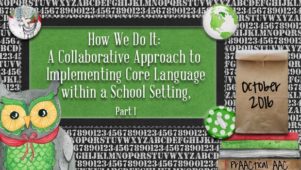
Nothing makes us smile like seeing teams in which professionals serving students with AAC needs work together to ensure that those students can use and grow their language skills. In this guest post, we learn about an approach that has worked for one such team, Lori Sanzeri and Chelsea Collins. Lori Sanzeri, MA CCC-SLP, TSHH, received her B.S. in Speech Language Pathology from SUNY Cortland in 2003 and M.A. from St. John’s University in 2009. She has worked for the NYC Department of Education since 2003 and teaches AAC and phonetics at St. John’s University. Chelsea Collins, MS CCC-SLP, TSSLD, received her B.S. in Special Education from Seton Hall University in 2009 and M.S. in Communicative Sciences and Disorders from New York University in 2012. She has worked for the NYC DOE since 2012 and specializes in AAC and early intervention. They are on Instagram as @thelanguageladies and have a Facebook page as... [Read More...]
October 20, 2016
by Carole Zangari -

Shared book reading is a great way to get families involved in building language and AAC skills. Today we’re back with another AT Recipe for Success from SLP Sara Barnhill and the AT Team at Children’s Hospital of Richmond at VCU. They’ve created several extension activities based on the book, Sometimes I Feel Sunny, to help families have fun and build AAC skills at the same time. As a member of the AT Core team, Sara is involved in AAC evaluations and therapy in the hospital’s clinics, out-patient program and Transitional Care Unit. CHoR’s AT Program is one of few comprehensive AT programs in Central Virginia. Their program provides AT evaluations, equipment and training to people of all ages, enabling children and adults with disabilities to function more independently. CHoR’s AT team consists of four SLPs, two OTs, one PT, and one Therapy Practice Assistant. In addition to completing transdiciplinary evaluations and treatments, CHoR’s AT team is... [Read More...]
October 6, 2016
by Carole Zangari -
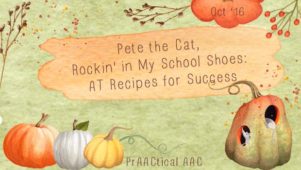
It’s time for another AT Recipe for Success with SLP Sara Barnhill and the AT Team at Children’s Hospital of Richmond at VCU. Today, we’re learning how they use extension activities based on the book, Pete the Cat Rockin’ in My School Shoes, to help families have fun and build AAC skills at the same time. Sara and her colleagues have been incredibly generous in sharing their work over the past several months. If you missed them over the the past few months, you can view previous posts here. Each one has parent handouts for you to download. As a member of the AT Core team, Sara is involved in AAC evaluations and therapy in the hospital’s clinics, out-patient program and Transitional Care Unit. CHoR’s AT Program is one of few comprehensive AT programs in Central Virginia. The program provides AT evaluations, equipment and training to people of all ages, enabling children and adults with disabilities to... [Read More...]
October 3, 2016
by Carole Zangari -
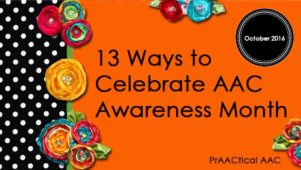
Need some ideas for celebrating AAC Awareness Month? Here are a few to get you started. Participate on the #USSAAC Twitterchat on 10/13 at 7:00 pm EDT (UTC−04:00). New to Twitterchats? You can learn more here. The wonderful Chris Bugaj will be moderating. Subscribe to a blog with an AAC content, such as Uncommon Sense, Jane Farrall Consulting, AAC Girls, or Superpower Speech Follow a new AAC topical Pinterest board from Lauren Enders and others: AAC and AT, AT/AAC/Adapt/Modify/Accessibility/Accommodations, AT for Communication, SLP AAC, & AugComm, AAC by Constantly Speaking, Communication-AAC Print, hang, or give someone an AAC awareness image, 10 Commandments of AAC Devices, or 5 Tips for Communicating with Nonverbal Student Register for a free AAC professional development webinar from Ablenet University Print out an AAC Poster, like Lauren Enders’ AAC Boot Camp-Getting AAC Users to Communicate or Kate Ahern’s The Periodic Table of AAC, Explore an AAC app or SGD that is new to you Print out song visual... [Read More...]
October 2, 2016
by Carole Zangari -
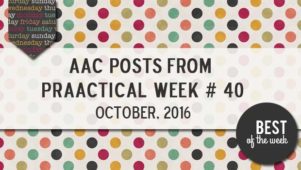
As many of you know, October is AAC Awareness Month, a time when the AAC community comes together to build understanding of complex communication needs in their communities, schools, and workplaces. It’s exciting to see how this movement is growing in every part of the world. If you share news of your events on social media, please tag us (@PrAACticalAAC on Facebook, Instagram, and Twitter) so that we can help you spread the word of your AAC awareness activities. Also, feel free to use the buttons and banners in this post in your own social media profiles or posts. In the meantime, here are links to a few posts you may have missed. Monday: Five Places for Shared AAC Materials Wednesday: Video of the Week: Shared Writing and AAC Thursday: PrAACtically October: A Year of Core Vocabulary Resources Social Media Images (PC users: right click to save image to your computer; Mac users: control... [Read More...]
September 29, 2016
by Carole Zangari -
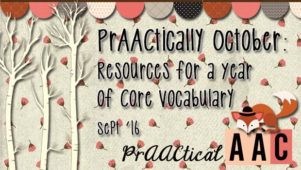
Know any AAC learners like these? Jeremiah has an SGD with thousands of core and fringe words, but he uses less than 100 of them in day-to-day life. Bella used an AAC app with visual scene displays to interact at playtime and during daily routines for the past several months. Her team just added an app with grid-based vocabulary so that she can begin to create novel sentences and expand her language abilities. Mason was recently evaluated for an AAC device, but it will likely take a few months to get the funding situation straightened out. In the meantime, his team created a manual communication board that mirrors the main screen of the SGD’s language software. Each of them need lots of practice to become fluent with the core words in their AAC systems. Are you looking for resources to support your use of core words in therapy, in the... [Read More...]
September 22, 2016
by Carole Zangari -
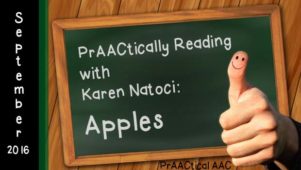
We are so happy to welcome back SLP Karen Natoci who graciously agreed to continue writing about how she uses interactive book reading to build language skills with beginning communicators. You can see her earlier posts in the PrAACtically Reading series here. In this post, she shares activity ideas for two books on apples. You can learn more about Karen and download her materials toward the bottom of the post. Enjoy! ::::::::::::::::::::::::::::::::::::::::::::::::::::::::: Books: Apples by Ken Robbins and Apples for Everyone by Jill Esbaum Adapted and simplified Powerpoint Book Apples by Karen Natoci Core Vocabulary focus: here, in, where Additional Vocabulary focus: Body parts; red, round, yellow, green, COMMUNICATION Matrix (Rowland, 2009) Level: I-VII (all levels!) ————————————————————————————————————————————- It is September and apple time! I chose to feature these books from which to adapt material suitable for students with complex communication needs. I have a simplified power point... [Read More...]
September 15, 2016
by Carole Zangari -
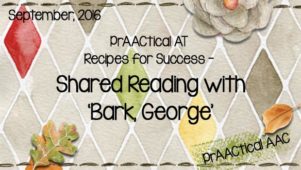
Thanks to all of you who have reached out with comments about the AT Recipes for Success and the wonderful resources shared by SLP Sara Barnhill and the AT Team at Children’s Hospital of Richmond at VCU. They’ve been incredibly generous in sharing their work over the past several months. If you missed them over the summer, you can view previous posts here. As a member of the AT Core team, Sara is involved in AAC evaluations and therapy in the hospital’s clinics, out-patient program and Transitional Care Unit. CHoR’s AT Program is one of few comprehensive AT programs in Central Virginia. The program provides AT evaluations, equipment and training to people of all ages, enabling children and adults with disabilities to function more independently. CHoR’s AT team consists of four SLPs, two OTs, one PT, and one Therapy Practice Assistant. In addition to completing transdiciplinary evaluations and treatments, CHoR’s AT team is... [Read More...]









